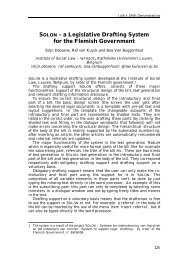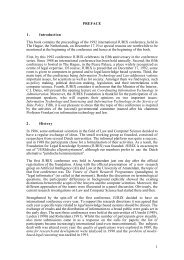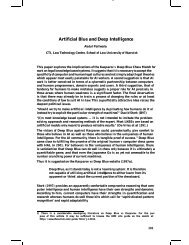On automatic causal reasoning for legal analysis - Jurix
On automatic causal reasoning for legal analysis - Jurix
On automatic causal reasoning for legal analysis - Jurix
Create successful ePaper yourself
Turn your PDF publications into a flip-book with our unique Google optimized e-Paper software.
7DEOH Function specification <strong>for</strong> the Case<br />
Function Domain Codomain Condition Value<br />
- - Ui i = 1,2 - yes<br />
no<br />
f1 U1 Defendant U1 = yes<br />
Otherwise<br />
selling<br />
¬selling<br />
f2 Defendant ∪<br />
U2<br />
Mother Defendant = selling ∧ U2 = yes<br />
Otherwise<br />
hiding<br />
¬hiding<br />
f3<br />
Defendant ∪<br />
Mother<br />
Boy<br />
Defendant = selling ∧<br />
Mother = ¬hiding<br />
Otherwise<br />
f4 Boy Playmate Boy = finding<br />
Otherwise<br />
f5 Playmate Plaintiff Playmate = shooting<br />
Otherwise<br />
U1 Defendant Mother U2<br />
finding<br />
¬finding<br />
shooting<br />
¬shooting<br />
wounded<br />
¬wounded<br />
Boy<br />
Playmate<br />
Plaintiff<br />
)LJXUH A Causal Functional Model of the Case<br />
We get the same negative answer to both of them. This is correct, but insufficiently stringent<br />
<strong>for</strong> our needs, because we would like to go beyond the individuation of contributory cause<br />
and determine causation in fact, i.e. one chain of causes and effects. In order to do this we<br />
have to refine our model and trans<strong>for</strong>m it into a Natural Causal Beam. This is done separately<br />
<strong>for</strong> each possible scenario (i.e., <strong>for</strong> each possible value of the Ui variables). We have to<br />
determine the minimal set of parents that sustains (i.e., that is sufficient <strong>for</strong>) the actual value<br />
of a variable. In our model we just have one variable with multiple parents: Boy. We will<br />
hence focus on this one, as the actual cause of the other ones is the actual value of the parent<br />
variable. Now, in the real scenario we say that the variable Defendant sustains the actual<br />
value of Boy more than Mother does. This is because if we change the value of Defendant<br />
also the value of Boy must change; while setting Mother = ¬hiding does not invariably imply<br />
Boy = ¬finding. This consideration <strong>for</strong>ces us to turn our model into the Natural Causal Beam<br />
shown in Figure 4 where f3 is modified as in Table 3, while all other functions remain<br />
unchanged. Running the counterfactual test on the beam gives us the actual cause of boy’s<br />
finding the weapon: the defendant’s act. This completes the chain of causation <strong>for</strong> the Case.<br />
7DEOH New function specification <strong>for</strong> the Case<br />
Function Domain Codomain Condition Value<br />
f3<br />
Defendant Boy Defendant = selling finding<br />
(modified)<br />
Otherwise<br />
¬finding<br />
Pearl’s system (correctly) detects the actual cause. This, on one hand, is very encouraging:<br />
his inference mechanism works nicely. And not only this: in contrast with Åqvist and<br />
Mullock’s <strong>for</strong>malism, Pearl’s does not rely on a SRVVLEOHZRUOG semantics, which is, at least<br />
so far, highly demanding at the computational level. <strong>On</strong> the other hand, though, the positive






